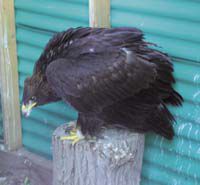| A Golden Eagle was recently found in Carbon County that tested positive for West Nile virus. One of the most important ways to prevent contracting West Nile virus from mosquitoes is by eliminating standing water sources and frequently changing the water in birdbaths and outdoor pet dishes. |
Southeastern Utah Health District confirmed Monday that west Nile virus has been detected in humans mosquitoes, birds, sentinel chickens and horses in Utah and several surrounding states.
The Utah Division of Wildlife Resources announced last Friday that the agency had found the virus in two counties.
On Aug 18, the DWR determined that a great horned owl from Uintah County was infected.
Two other instances were discovered in Carbon County on Aug. 22. A sharp-shinned hawk and a Golden Eagle were found to be infected in the first instance of west Nile Virus in birds in Carbon County.
The division of wildlife services submitted samples from the birds to the Utah Public Health Laboratory for testing.
Laboratory reports indicated that all three were positive for the virus.
The DWR indicated that the division plans to continue surveillance of wild birds as necessary.
As agencies track the west Nile virus, the viral activity in birds is an indicator of its spread.
Birds are often infected with the virus prior to the detection of cases in humans.
To prevent the spread of the virus to humans, the health department continues the agency’s campaign urging the public to wear insect repellent, especially during night hours.
The virus is transmitted to humans by the Culex mosquito, a species that bites after dusk and before dawn.
In addition, the health department has suggested wearing long sleeves and long pants when possible and using insect repellent containing DEET. Repellents containing DEET are safe when used properly and are among the most effective repellents available.
In addition, homeowners should check their window screens and screened doors. Small holes may allow mosquitoes to enter.
Standing water should be changed regularly. This includes birdbaths and outdoor pet dishes. Water should be changed at least every two to three days.
Ornamental ponds should be aerated. For assistance regarding treatment options of ornamental ponds, members of the public should contact their local mosquito abatement district.
Finally, property owners should eliminate standing water that may have collected in old tires, cans, poorly-kept swimming pools or any other source wher stagnant water accumulates.
Many people infected with West Nile Virus do not show symptoms. One in five have flu-like symptoms with fever, muscle aches and possibly a rash.
An estimated one in 150 develop more severe illness which can affect the brain and spinal cord. Those who are affected more seriously may show symptoms such as headache, paralysis and still neck.
The risk of severe illness increases with age, but health officials remind the public that there is no age at which there is no risk of illness.
More information regarding the virus can be obtained from the health department’s Price office by calling (435) 637-3671 or stopping by the office located at 28 S. 100 East. Information is available on the Internet at http://www.health.utah.gov/wnv/. Information on the website is updates weekly.
The DWR encourages the public to participate in the wild bird surveillance program. Target species for testing this year include birds of the Corvid family. These include ravens, crows, jays and similar birds. Raptors and other species that exhibit neurological symptoms are also included.
Before contacting the division of wildlife resources with a report, the division urges members of the public to ask questions to determine whether the bird is part of the surveillance program. Questions to ask include:
•Is the bird a target species? Is it a Raven, crow, jay, bird of prey or does the bird appear to be ill or dying?
•Has the bird been dead for less than 24 hours. Birds that have been dead longer than 24 hours appear decayed and are not suitable for testing.
•Is there no obvious cause of death? These may include window strikes, cat-kills or collisions with vehicles.
Those who see a bird that fits the guidelines for the surveillance program should contact the DWR office in Price at (435) 636-0260 or stop by the office located at 475 West Price River Drive, Suite C. Those with access to the Internet may report sightings at http://www.wildlife.utah.gov/wnv/.

